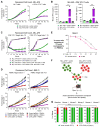Inhibition of the CtBP complex and FBXO11 enhances MHC class II expression and anti-cancer immune responses
- PMID: 36179686
- PMCID: PMC7615013
- DOI: 10.1016/j.ccell.2022.09.007
Inhibition of the CtBP complex and FBXO11 enhances MHC class II expression and anti-cancer immune responses
Abstract
There is increasing recognition of the prognostic significance of tumor cell major histocompatibility complex (MHC) class II expression in anti-cancer immunity. Relapse of acute myeloid leukemia (AML) following allogeneic stem cell transplantation (alloSCT) has recently been linked to MHC class II silencing in leukemic blasts; however, the regulation of MHC class II expression remains incompletely understood. Utilizing unbiased CRISPR-Cas9 screens, we identify that the C-terminal binding protein (CtBP) complex transcriptionally represses MHC class II pathway genes, while the E3 ubiquitin ligase complex component FBXO11 mediates degradation of CIITA, the principal transcription factor regulating MHC class II expression. Targeting these repressive mechanisms selectively induces MHC class II upregulation across a range of AML cell lines. Functionally, MHC class II+ leukemic blasts stimulate antigen-dependent CD4+ T cell activation and potent anti-tumor immune responses, providing fundamental insights into the graft-versus-leukemia effect. These findings establish the rationale for therapeutic strategies aimed at restoring tumor-specific MHC class II expression to salvage AML relapse post-alloSCT and also potentially to enhance immunotherapy outcomes in non-myeloid malignancies.
Keywords: CtBP; FBXO11; MHC class II; acute myeloid leukemia; bone marrow transplantation; cancer epigenetics; gene regulation; melanoma; tumor immunology.
Copyright © 2022 Elsevier Inc. All rights reserved.
Conflict of interest statement
Declaration of interests M.A.D. has been a member of advisory boards for GlaxoSmithKline, CTx CRC, Storm Therapeutics, Celgene, and Cambridge Epigenetix. S.-J.D. has been a member of advisory boards for AstraZeneca. The M.A.D. and S.-J.D. laboratories have received research funding from CTx CRC and Pfizer. The S.-J.D. laboratory has received research funding from Genentech. P.A.B. has received research funding from AstraZeneca, Bristol Myers Squibb, and Gilead Sciences. A.H.W. has been a member of advisory boards for Novartis, Janssen, Amgen, Roche, Pfizer, Abbvie, Servier, Gilead, BMS, Macrogenics, and Agios, receives research funding to the Institution from Novartis, Abbvie, Servier, BMS, Astra Zeneca, and Amgen, and serves on speaker’s bureaus for Abbvie, Novartis, and BMS. All other authors declare no competing interests.
Figures







References
-
- Aubrey BJ, Kelly Gemma L, Kueh Andrew J, Brennan Margs S, O’Connor L, Milla L, Wilcox S, Tai L, Strasser A, Herold Marco J. An Inducible Lentiviral Guide RNA Platform Enables the Identification of Tumor-Essential Genes and Tumor-Promoting Mutations In Vivo. Cell Rep. 2015;10:1422–1432. - PubMed
-
- Becht E, McInnes L, Healy J, Dutertre CA, Kwok IWH, Ng LG, Ginhoux F, Newell EW. Dimensionality reduction for visualizing single-cell data using UMAP. Nat Biotechnol. 2018 - PubMed
-
- Bejanyan N, Weisdorf DJ, Logan BR, Wang H-L, Devine SM, de Lima M, Bunjes DW, Zhang M-J. Survival of Patients with Acute Myeloid Leukemia Relapsing after Allogeneic Hematopoietic Cell Transplantation: A Center for International Blood and Marrow Transplant Research Study. Biol Blood Marrow Transplant. 2015;21:454–459. - PMC - PubMed
Publication types
MeSH terms
Substances
Grants and funding
LinkOut - more resources
Full Text Sources
Medical
Molecular Biology Databases
Research Materials

